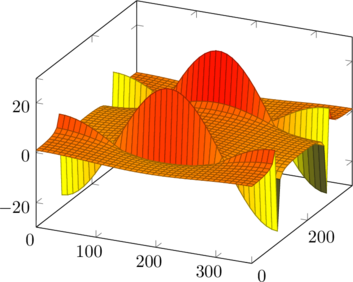In this post, I would like to talk about several recent papers about topic models. These papers may not belong to the same direction of applying or extending topic models. However, some of them are quite interesting and worth to be discussed here.
The first one is
Enhong Chen, Yanggang Lin, Hui Xiong, Qiming Luo, and Haiping Ma. 2011. Exploiting probabilistic topic models to improve text categorization under class imbalance. Journal of Information Processing and Management. 47, 2 (March 2011), 202-214.
The idea is straightforward and simple. The author proposed a two-step approach to mitigate the problem of unbalanced data. The first step is to learn topic models from the existing unbalanced data. Here, for each class label, a separate set of topics is learned. Once the models are obtained, synthetic documents or new samples are drawn from learned models. This is possible since topic distribution and word distribution are fixed after learning process. The number of new samples is determined by the difference between the dominant class and the rare class. A more aggressive method is also proposed, which is used to avoid noisy labeled data. The idea is to use all synthetic samples to train a classifier, rather than original samples. The experimental results demonstrate some performance improvement of this method over other ones that are proposed to tackle the same problem.
The second paper is
Wayne Xin Zhao, Jing Jiang, Hongfei Yan, and Xiaoming Li. 2010. Jointly modeling aspects and opinions with a MaxEnt-LDA hybrid. In Proceedings of the 2010 Conference on Empirical Methods in Natural Language Processing (EMNLP ’10). Association for Computational Linguistics, Stroudsburg, PA, USA, 56-65.
The paper is interesting because it also demonstrates a method to incorporate term-level features into a topic model. The list of features for each term is embedded through a Maximum Entropy Model. The supervised learning part of the model learns the fixing weights of these features and Gibbs sampling for the topic model uses these weights. For details, please refer to the paper.
The next one is
Xin Zhao, Jing Jiang, Jianshu Weng, Jing He, Ee-Peng Lim, Hongfei Yan and Xiaoming Li. Comparing Twitter and traditional media using topic models. In Proceedings of the 33rd European Conference on Information Retrieval (ECIR’11) (full paper), 2011.
The paper has several interesting aspects. First, it is claimed as a first study of topics obtained on Twitter and other traditional media. The authors use a standard LDA model to discover topics from NewYorkTimes corpus and a modified topic model for Twitter, separately. Then, they proposed a heuristic method to map Twitter topics onto NYT topics. In addition, they manually assigned topic types to all the topics found by models. By doing all these, common topics and corpus-specific topics are obtained heuristically. It’s a little bit strange that they do not consider any techniques to mine topics from multiple corpus. Secondly, they do not compare to the method where only LDA is used. Note, the same Twitter-LDA is used in:
Xin Zhao, Jing Jiang, Jing He, Yang Song, Palakorn Achanauparp, Ee-Peng Lim and Xiaoming Li. Topical keyphrase extraction from Twitter. To appear in Proceedings of the 49th Annual Meeting of the Association for Computational Linguistics: Human Language Technologies (ACL-HLT’11) (long paper), 2011.

![Rendered by QuickLaTeX.com \[ <span class="ql-right-eqno"> (1) </span><span class="ql-left-eqno"> </span><img src="https://www.hongliangjie.com/wp-content/ql-cache/quicklatex.com-26f49852a50c1f981273da59a3d7de67_l3.png" height="213" width="233" class="ql-img-displayed-equation " alt="\begin{eqnarray*}P(-x) &=& \frac{1}{1+\exp(x)} \nonumber \\&=& \frac{1}{1+\frac{1}{\exp(-x)}} \nonumber \\&=& \frac{\exp(-x)}{1+\exp(-x)} \nonumber \\&=& 1 - \frac{1}{1+\exp(-x)} \nonumber \\&=& 1 - P(x) \; \; \qquad (2)\end{eqnarray*}" title="Rendered by QuickLaTeX.com"/> \]](https://www.hongliangjie.com/wp-content/ql-cache/quicklatex.com-42d346a397a5ef77a0c95da4f9c5ceb9_l3.png)
![Rendered by QuickLaTeX.com \[ <span class="ql-right-eqno"> (2) </span><span class="ql-left-eqno"> </span><img src="https://www.hongliangjie.com/wp-content/ql-cache/quicklatex.com-0d2ec58cfdefbc85b337c9195b7e9d47_l3.png" height="96" width="333" class="ql-img-displayed-equation " alt="\begin{eqnarray*}P(y = 1 \, | \, \boldsymbol{\beta}, \mathbf{x}) &=& \frac{\exp(\boldsymbol{\beta}^{T} \mathbf{x})}{1 + \exp(\boldsymbol{\beta}^{T} \mathbf{x})} \nonumber \\P(y = 0 \, | \, \boldsymbol{\beta}, \mathbf{x}) &=& \frac{1}{1 + \exp(\boldsymbol{\beta}^{T} \mathbf{x})} \;\; \qquad (3)\end{eqnarray*}" title="Rendered by QuickLaTeX.com"/> \]](https://www.hongliangjie.com/wp-content/ql-cache/quicklatex.com-9a74f66d1bb17a71c128557f173bd7e0_l3.png)
![Rendered by QuickLaTeX.com \[ <span class="ql-right-eqno"> (3) </span><span class="ql-left-eqno"> </span><img src="https://www.hongliangjie.com/wp-content/ql-cache/quicklatex.com-ab78efd52d92fe6f7a6a48a6387e0bce_l3.png" height="19" width="276" class="ql-img-displayed-equation " alt="\begin{equation*}P(y=1 \, | \, \boldsymbol{\beta}, \mathbf{x}) = 1 - P(y=0 \, | \, \boldsymbol{\beta}, \mathbf{x})\end{equation*}" title="Rendered by QuickLaTeX.com"/> \]](https://www.hongliangjie.com/wp-content/ql-cache/quicklatex.com-18581b7919baa6007aacf245b60a1972_l3.png)
![Rendered by QuickLaTeX.com \[ <span class="ql-right-eqno"> (4) </span><span class="ql-left-eqno"> </span><img src="https://www.hongliangjie.com/wp-content/ql-cache/quicklatex.com-adce25678a6ba44c60e8e18024431334_l3.png" height="43" width="347" class="ql-img-displayed-equation " alt="\begin{equation*}P(g= \pm 1 \, | \, \boldsymbol{\beta}, \mathbf{x}) = \frac{1}{1 + \exp( - g\boldsymbol{\beta}^{T} \mathbf{x})} \;\; \qquad (4)\end{equation*}" title="Rendered by QuickLaTeX.com"/> \]](https://www.hongliangjie.com/wp-content/ql-cache/quicklatex.com-55c297fcdaba8e509f70fdfa37302b5d_l3.png)
![Rendered by QuickLaTeX.com \[ <span class="ql-right-eqno"> (5) </span><span class="ql-left-eqno"> </span><img src="https://www.hongliangjie.com/wp-content/ql-cache/quicklatex.com-e86023543d98b569af5f56638c5993ff_l3.png" height="175" width="278" class="ql-img-displayed-equation " alt="\begin{eqnarray*}P(y = 1 \, | \, \boldsymbol{\beta}, \mathbf{x}) &=& \frac{\exp(\boldsymbol{\beta}^{T} \mathbf{x})}{1 + \exp(\boldsymbol{\beta}^{T} \mathbf{x})} \nonumber \\&=& \frac{1}{\frac{1}{\exp(\boldsymbol{\beta}^{T} \mathbf{x})} + 1} \nonumber \\&=& \frac{1}{\exp(-\boldsymbol{\beta}^{T} \mathbf{x}) + 1} \nonumber \\&=& P(g= 1 \, | \, \boldsymbol{\beta}, \mathbf{x})\end{eqnarray*}" title="Rendered by QuickLaTeX.com"/> \]](https://www.hongliangjie.com/wp-content/ql-cache/quicklatex.com-4ddd8c95a47dad31270f1962ba10f5ac_l3.png)
![Rendered by QuickLaTeX.com \[ <span class="ql-right-eqno"> (6) </span><span class="ql-left-eqno"> </span><img src="https://www.hongliangjie.com/wp-content/ql-cache/quicklatex.com-bb3dda211fa7695381356592f2eac0f8_l3.png" height="117" width="225" class="ql-img-displayed-equation " alt="\begin{eqnarray*}\frac{\frac{\exp(\boldsymbol{\beta}^{T} \mathbf{x})}{1 + \exp(\boldsymbol{\beta}^{T} \mathbf{x})}}{\frac{1}{1 + \exp(\boldsymbol{\beta}^{T} \mathbf{x})}} & > & 1 \;\; \rightarrow \;\; y = 1 \nonumber \\\exp(\boldsymbol{\beta}^{T} \mathbf{x}) & > & 1 \nonumber \\\boldsymbol{\beta}^{T} \mathbf{x} & > & 0\end{eqnarray*}" title="Rendered by QuickLaTeX.com"/> \]](https://www.hongliangjie.com/wp-content/ql-cache/quicklatex.com-8c6bba07a730a338dab0793007011abb_l3.png)
![Rendered by QuickLaTeX.com \[ <span class="ql-right-eqno"> (7) </span><span class="ql-left-eqno"> </span><img src="https://www.hongliangjie.com/wp-content/ql-cache/quicklatex.com-110b1c3ae6ac1d5eeddfaffa87acae4c_l3.png" height="166" width="264" class="ql-img-displayed-equation " alt="\begin{eqnarray*}\frac{\frac{1}{1 + \exp( - \boldsymbol{\beta}^{T} \mathbf{x})}}{\frac{1}{1 + \exp( \boldsymbol{\beta}^{T} \mathbf{x})}} & > & 1 \;\; \rightarrow \;\; g = 1 \nonumber \\\frac{1 + \exp(\boldsymbol{\beta}^{T} \mathbf{x})}{1 + \exp( - \boldsymbol{\beta}^{T} \mathbf{x})} & > & 1 \nonumber \\\exp(\boldsymbol{\beta}^{T} \mathbf{x}) & > & 1 \nonumber \\\boldsymbol{\beta}^{T} \mathbf{x} & > & 0\end{eqnarray*}" title="Rendered by QuickLaTeX.com"/> \]](https://www.hongliangjie.com/wp-content/ql-cache/quicklatex.com-9ad0644e968541888a1a3d6ad55a5d3f_l3.png)
![Rendered by QuickLaTeX.com \[ <span class="ql-right-eqno"> (8) </span><span class="ql-left-eqno"> </span><img src="https://www.hongliangjie.com/wp-content/ql-cache/quicklatex.com-7b2ccccdd2c250978dabe7bef0c428ee_l3.png" height="42" width="183" class="ql-img-displayed-equation " alt="\begin{equation*}\arg\min \sum_{i} L\Bigr(y_{i},f(\mathbf{x}_{i})\Bigl)\end{equation*}" title="Rendered by QuickLaTeX.com"/>\]](https://www.hongliangjie.com/wp-content/ql-cache/quicklatex.com-df99f36ed6aedb2edb3f330175f08294_l3.png)
![Rendered by QuickLaTeX.com \[ <span class="ql-right-eqno"> (9) </span><span class="ql-left-eqno"> </span><img src="https://www.hongliangjie.com/wp-content/ql-cache/quicklatex.com-38105dc931573fa3c94d601dccba3b8a_l3.png" height="59" width="296" class="ql-img-displayed-equation " alt="\begin{eqnarray*}f(\mathbf{x}) &=& \boldsymbol{\beta}^{T} \mathbf{x} \nonumber \\L\Bigr(y,f(\mathbf{x})\Bigl) &=& \log \Bigr( 1 + \exp(-y f(\mathbf{x})\Bigl)\end{eqnarray*}" title="Rendered by QuickLaTeX.com"/>\]](https://www.hongliangjie.com/wp-content/ql-cache/quicklatex.com-262ad5197f16fece83b161c03c7c6803_l3.png)